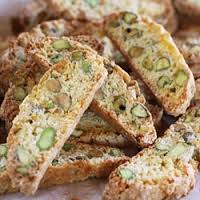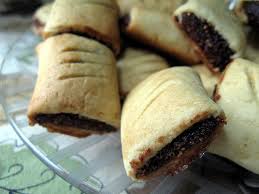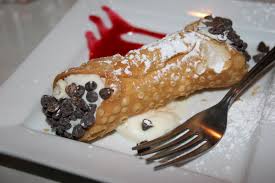
It’s been said that no Italian would willingly choose tea over coffee, and considering the supreme quality of Italian espresso drinks, who can blame them? That being said, Kathleen found an example to the contrary one very cold winter’s day in London. She was lucky enough to be having afternoon tea in the almost empty lobby of the Dorchester Hotel when she deduced that the party of glamorous young ladies at the next table were Italians chatting animatedly over their tea. Doing a little digging into the Italian attitude toward tea, Kathleen found that when tea is consumed, it is a classic black tea blend such as English Breakfast or an herbal tisane with an anise base or chamomile. It is the Italian custom to have sweets not as a dessert after a meal but mid-morning or mid-afternoon with espresso. Using the American melting pot as our model, we will feature delicious Italian savories and pastries, creatively blending tea culture with Italian-American culture. Buon appetito!
Menu
Beverages:
English Breakfast hot tea
Chamomile hot tea
Espresso
Sweet Marsala or Prosecco
Savories:
Antipasti Platter including olives, fresh fennel, sliced yellow and red bell peppers, baby carrots, marinated mushrooms, and celery
Polenta and Roasted Pepper Timbales
Eggplant Roll-Ups
Artichoke Heart Focaccia
Caprese Salads
Sweets:
Pistachio and Golden Raisin Biscotti
Amaretti
Sammartini (Cuccidati) Spiced Fig Cookies
Almost Classic Cannoli
Panforte
Cassata alla Siciliana (On the Pedestal)
Beverages:
English Breakfast hot tea
Chamomile hot tea
Espresso
Sweet Marsala or Prosecco
Savories:
Antipasti Platter including olives, fresh fennel, sliced yellow and red bell peppers, baby carrots, marinated mushrooms, and celery
Polenta and Roasted Pepper Timbales
Eggplant Roll-Ups
Artichoke Heart Focaccia
Caprese Salads
Sweets:
Pistachio and Golden Raisin Biscotti
Amaretti
Sammartini (Cuccidati) Spiced Fig Cookies
Almost Classic Cannoli
Panforte
Cassata alla Siciliana (On the Pedestal)
|
Recipes Included:
Polenta and Roasted Pepper Timbales Yellow polenta, the best of Italian peasant food, here is dressed up in contrasting colors of red pepper and dark green capers. Molded in timbale shapes in a muffin pan, they are ready to be neatly served to tea party guests as part of the Italian tea menu. Moisten with best-quality extra-virgin olive oil just before serving. Eggplant Roll-Ups These petit eggplant bites feature a creamy filling bursting with fresh Italian herbs. We are using long, slender Japanese eggplants to get small-sized slices. They may be dark purple like the Italian globe eggplants or a lighter lavender color. Whatever the color, they are less bitter than their Italian cousins and needn’t be salted to remove any bitterness. Artichoke Heart Focaccia While you can find fresh and tasty Artichoke Heart Focaccia in good quality grocery stores and Italian delis, you can also make your own. Use our Herbed Focaccia recipe and follow the instructions to make the Artichoke Heart Focaccia Variation. This Focaccia would also be delicious with the Olive Tapenade, which is also included with the Herbed Focaccia recipe. Caprese Salads (Tomato, Basil and Mozzarella Salads) This beautiful salad exemplifies the very best qualities of Italian cuisine—freshness, simplicity and deep satisfying flavor. It is gorgeous to look at, easy to make and memorable, like a painting that one thinks about hours and even years after one has viewed it. This little masterpiece is composed of three basic ingredients—fresh mozzarella cheese, ripe tomatoes and fresh basil leaves stacked on top of each other to create individual servings. Make sure to buy fresh mozzarella, which has a soft texture and a pale whitish color. And do not skimp on any of the other ingredients. Only the best will do for a salad this good. Pistachio and Golden Raisin Biscotti The pistachios add a lovely flavor as well as a soft green accent to these traditional Italian cookies. Marsala, a sweet dessert wine, adds a subtle warm taste to the dough but apple cider or orange juice may be substituted, if preferred. Chopped dried apricots or currants may be used in place of the raisins; this is a great recipe to modify, making your own signature biscotti. Designed to keep better than most cookies, packaged in cellophane bags and tied with ribbon, biscotti make great gifts or party favors. Amaretti (Almond Macaroons) Italian Almond Macaroons, known as Amaretti, originated in Venice during the Renaissance. These little dome shaped cookies have stood the test of time because they are are incredibly good. They are crunchy on the outside and wonderfully chewy on the inside with a deep almond flavor. They are also favorite ingredients to add to a Trifle or any number of other desserts, just to bring a little extra taste and texture. Sammartini (Cuccidati) Spiced Fig Cookies Kathleen’s grandfather brought this recipe over from his native Calabria. The cookies are traditionally made at Christmas time. The name sammartini seems to be specific to the Pedulla family—we have not encountered it elsewhere. Sicilians use the term cuccidati or “cucci.” The cookies can be made in many shapes; our favorite shape is in the form of Fig Newtons, though not as compressed. It would simply not be a holiday without Rudy’s sammartini! Almost Classic Cannoli Classic Cannoli feature day-glo red and green candied cherries and chunks of petrified citron; these are the only things missing from our Almost Classic Cannoli recipe. Instead you’ll find homemade deep-fried shells and creamy ricotta filling scented with orange zest and orange liqueur, as well as honey and chopped chocolate. If you happen to have home-candied orange peel, by all means add a finely chopped tablespoon or two. We really don’t think you’ll miss the other stuff. Panforte Panforte, which means “strong bread” in Italian, is the ancient version of fruitcake. It contains ingredients that would have been available even to pre-historic people living in the Mediterranean region—nuts, dried fruits and honey. As its name suggests, Panforte is a very dense and heavy cake intended to be eaten in small pieces. It lasts for months if wrapped well and stored in a cool dark place, and the flavors improve with time. We imagine medieval pilgrims and crusaders carrying Panforte along with them to their far-off destinations. Panforte pairs well with cheese and of course with Italian dessert wines. Our Panforte recipe adds a little spice and cocoa for a slightly updated version of this venerable cake. We recommend baking your Panforte a month before you plan to serve it to allow the flavors to meld. This recipe makes a very large 9-inch round loaf of Panforte, more than you will need for your Italian Afternoon Tea. We suggest cutting small bite sized pieces and serving them with the other sweet finger foods on the menu—the Biscotti, the Amaretti and the Sammartini Cookies, on an attractive tiered server. You will have plenty of Panforte left to share with family and friends in the days or months ahead. Cassata alla Siciliana Cassata alla Siciliana, as its name suggests, is a cake of Sicilian origin. Like Panforte, this very ancient dessert makes use of the local ingredients—candied fruits, nuts, eggs and cheese—that were available to people living along the Mediterranean centuries ago. As such, Cassata is one of the world’s first cheesecakes, although the ricotta filling is sandwiched between two layers of golden sponge cake rather than baked. This sponge cake, called Pan di Spagna in Italian, can also be layered with gelato or spumoni and frozen for an Italian ice cream cake. |

















